Imagine this: It’s a special dinner night, and you want to impress your family or guests with something unforgettable. But you’re stuck wondering what could possibly tick all the boxes—delicious, elegant, and surprisingly easy to prepare. This ribeye roast recipe is here to save the day! With its tender, juicy flavors and a perfectly seasoned crust, it’s a showstopper on any table. Whether you’re a seasoned chef or a beginner looking for a no-fail recipe, this one guarantees success every time. First, let’s dive into what makes this recipe so special!
Now picture this—your kitchen filled with the comforting aroma of a roast sizzling to perfection. This recipe isn’t just about the flavors; it’s about the experience, too. It’s versatile, healthy, and surprisingly simple to pull off. You’re going to love how every bite melts in your mouth, leaving you craving more. Ready to master the ultimate roast? Let’s get started!
Table of Contents
Everything You Need to Know About Ribeye Roast
What Makes Ribeye Roast the Ultimate Cut of Beef?
A ribeye roast is the king of cuts when it comes to beef. First, it’s known for its rich marbling, which means tiny streaks of fat run through the meat. These melt as the roast cooks, creating incredible juiciness and flavor. Unlike other cuts, ribeye roast has the perfect balance of tenderness and beefy richness, making every bite a treat.
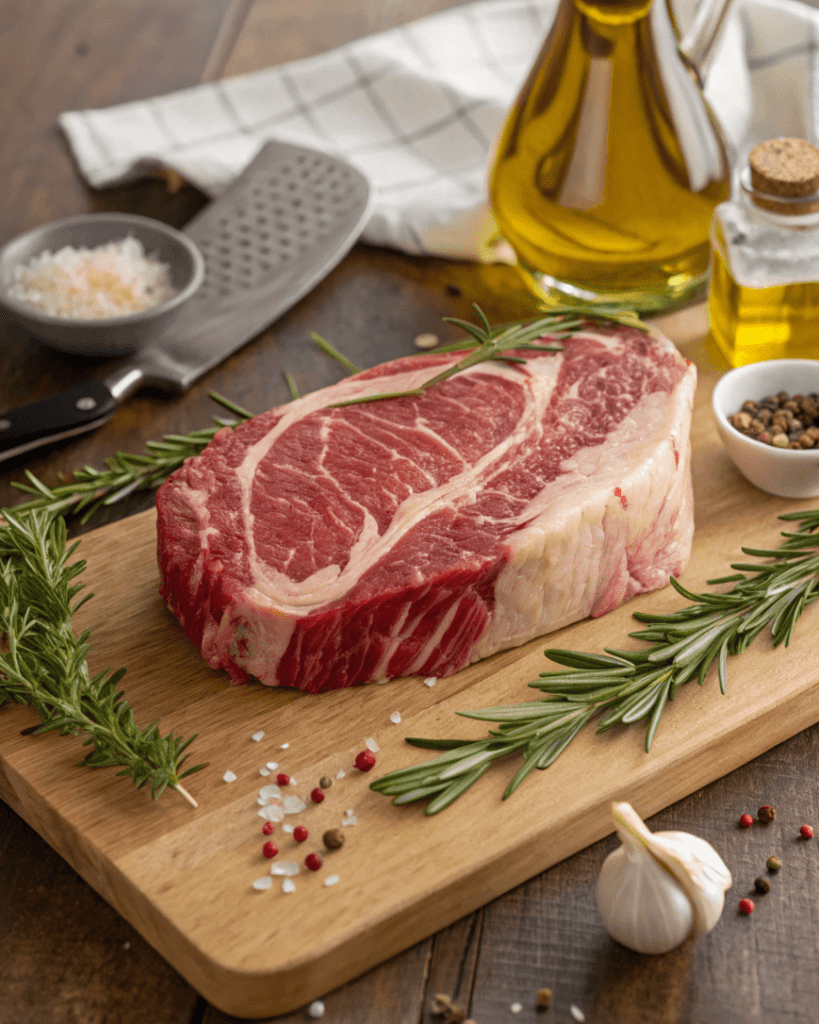
Next, the texture is a game-changer. It’s tender enough to cut with a fork but firm enough to hold its shape when sliced. This makes it ideal for family dinners, celebrations, or even a fancy Sunday meal. You’ll also love how versatile it is. Whether you slow-roast it, sear it, or bake it, the ribeye roast delivers amazing results every time.
Also, this cut is forgiving. Even if you’re a beginner, you can make it taste like a professional chef cooked it. The key is to season it well and cook it at the right temperature. That’s the secret to bringing out its natural flavors.
To make things easier, here’s a quick look at the ribeye roast’s best qualities:
| Quality | Why It’s Amazing |
|---|---|
| Marbling | Adds juiciness and boosts flavor |
| Tenderness | Soft texture that melts in your mouth |
| Versatility | Works with many cooking methods and seasonings |
| Rich Flavor | Perfect balance of fat and beefy goodness |
Once you try this ribeye roast recipe, you’ll see why it’s everyone’s favorite cut. It’s a crowd-pleaser that guarantees compliments at the dinner table. For those exploring other bold cuts of beef, consider learning why don’t more people eat beef heart. It’s an underrated yet flavorful option that pairs wonderfully with hearty meals like ribeye.
Ribeye Roast vs. Prime Rib: Key Differences Explained
The terms “ribeye roast” and “prime rib” are often used interchangeably, but they aren’t exactly the same. Let’s break it down so you know what sets them apart.
First, the ribeye roast is a boneless cut, while prime rib typically includes the bone. The bone in prime rib gives it a more dramatic presentation, but the ribeye roast is easier to cook and carve. Second, prime rib is often seasoned and slow-roasted as a whole piece, making it ideal for large gatherings. Meanwhile, ribeye roast can be portioned out, giving you more flexibility for smaller meals.
Another key difference lies in flavor. Both are rich, but prime rib has a slightly deeper beefy taste because it’s roasted with the bone. On the other hand, ribeye roast has consistent tenderness and is easier to handle in the kitchen.
For clarity, here’s a table highlighting the key differences:
| Feature | Ribeye Roast | Prime Rib |
|---|---|---|
| Bone | Boneless | Bone-in |
| Cooking Style | Flexible (roasting, searing) | Typically slow-roasted |
| Flavor Profile | Tender and rich | Deep, beefy flavor |
| Ease of Carving | Very easy | More challenging |
Ultimately, the choice depends on your preference and the occasion. For a simple yet elegant dinner, the ribeye roast wins every time. Once you understand these differences, you’ll appreciate why this ribeye roast recipe is the go-to for both beginners and experienced cooks alike.
Step-by-Step Preparation for a Ribeye Roast
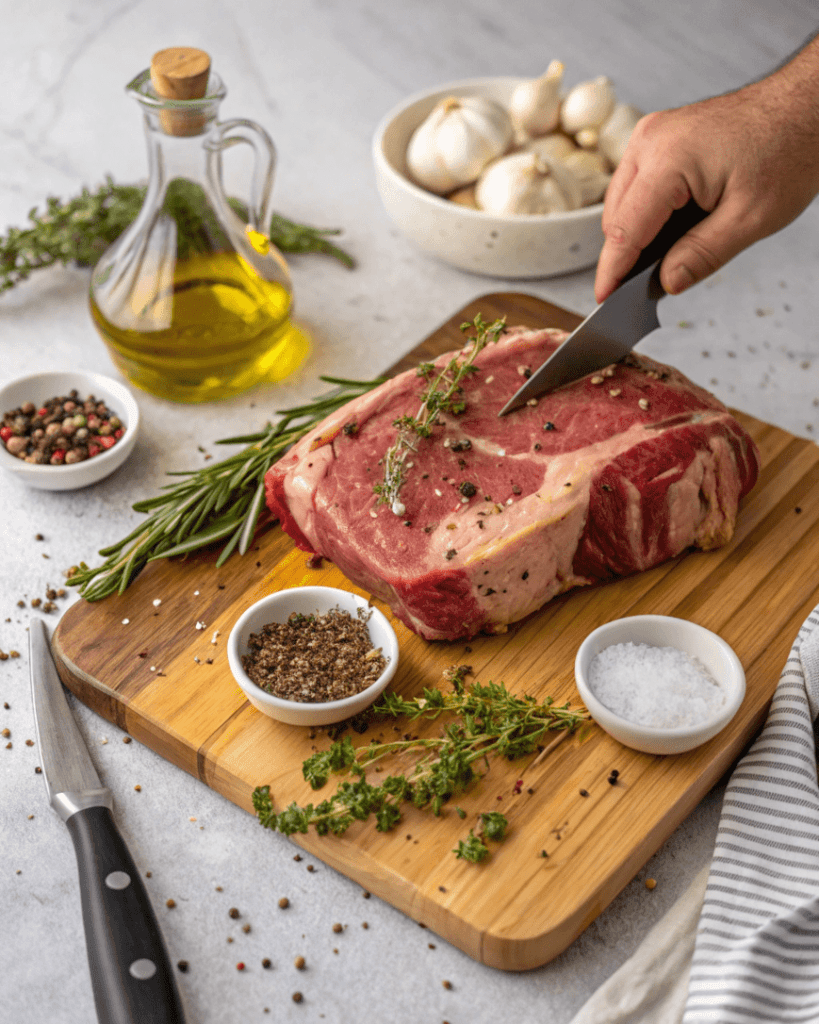
Choosing the Best Ribeye Roast: Marbling and Quality Matter
When it comes to picking the perfect ribeye roast, marbling is your best friend. Marbling refers to the thin streaks of fat that run through the meat. These fat lines melt during cooking, making the meat juicy, tender, and incredibly flavorful. The more marbling, the better your roast will taste!
First, always look for a roast with even marbling throughout. This ensures consistent flavor in every bite. Next, check the color of the meat. A high-quality ribeye roast should be bright red with no brown spots or discoloration. The fat should also be creamy white, not yellowish.
In addition, pay attention to the grade of beef. USDA Prime is the top tier, offering superior marbling and tenderness. USDA Choice is also a great option and more budget-friendly. Lastly, consider the roast’s weight. Plan for about 1 pound per person to ensure everyone gets enough.
Here’s a quick table to guide you:
| Factor | What to Look For |
|---|---|
| Marbling | Evenly distributed fat streaks |
| Meat Color | Bright red with no discoloration |
| Fat Color | Creamy white, not yellowish |
| Grade | USDA Prime or USDA Choice |
| Weight | About 1 pound per person |
By choosing a well-marbled, high-quality ribeye roast, you set the stage for a meal to remember.
How to Properly Season a Ribeye Roast for Maximum Flavor
Seasoning your ribeye roast is where the magic happens. A perfectly seasoned roast enhances the natural flavors of the meat, creating an irresistible dish.
Start by patting the roast dry with paper towels. This helps the seasoning stick better. Then, generously coat the roast with salt and pepper as a base. Don’t be shy—this step creates a flavorful crust.
For added depth, use a blend of fresh and dried herbs like rosemary, thyme, and garlic. Olive oil works as a binder, helping the seasoning stick while adding a hint of richness.
Here’s a simple step-by-step guide:
- Pat the ribeye roast dry with paper towels.
- Rub olive oil all over the roast.
- Generously sprinkle salt and pepper on all sides.
- Add minced garlic, chopped rosemary, and thyme for extra flavor.
- Let the roast sit for 30 minutes to absorb the seasoning.
Here’s a chart of seasoning ratios for different roast sizes:
| Roast Size | Salt | Pepper | Garlic (minced) | Herbs (chopped) |
|---|---|---|---|---|
| 3 pounds | 2 teaspoons | 1 teaspoon | 2 cloves | 1 tablespoon |
| 5 pounds | 1 tablespoon | 2 teaspoons | 3 cloves | 2 tablespoons |
| 7 pounds | 1.5 tablespoons | 1 tablespoon | 4 cloves | 3 tablespoons |
Proper seasoning ensures your ribeye roast tastes as amazing as it looks. Once you try this method, you’ll never look back! If you’re curious about preparing other unique cuts of beef, beef heart recipes are an excellent way to expand your culinary skills while embracing bold flavors.
Foolproof Cooking Techniques for Ribeye Roast
Slow Roasting vs. High-Heat Methods: What Works Best
Choosing between slow roasting and high-heat methods can make a big difference in how your ribeye roast turns out. Slow roasting is perfect if you want tender, evenly cooked meat. It involves cooking the roast at a low temperature, allowing the heat to penetrate gradually. This method is ideal for beginners since it minimizes the risk of overcooking.
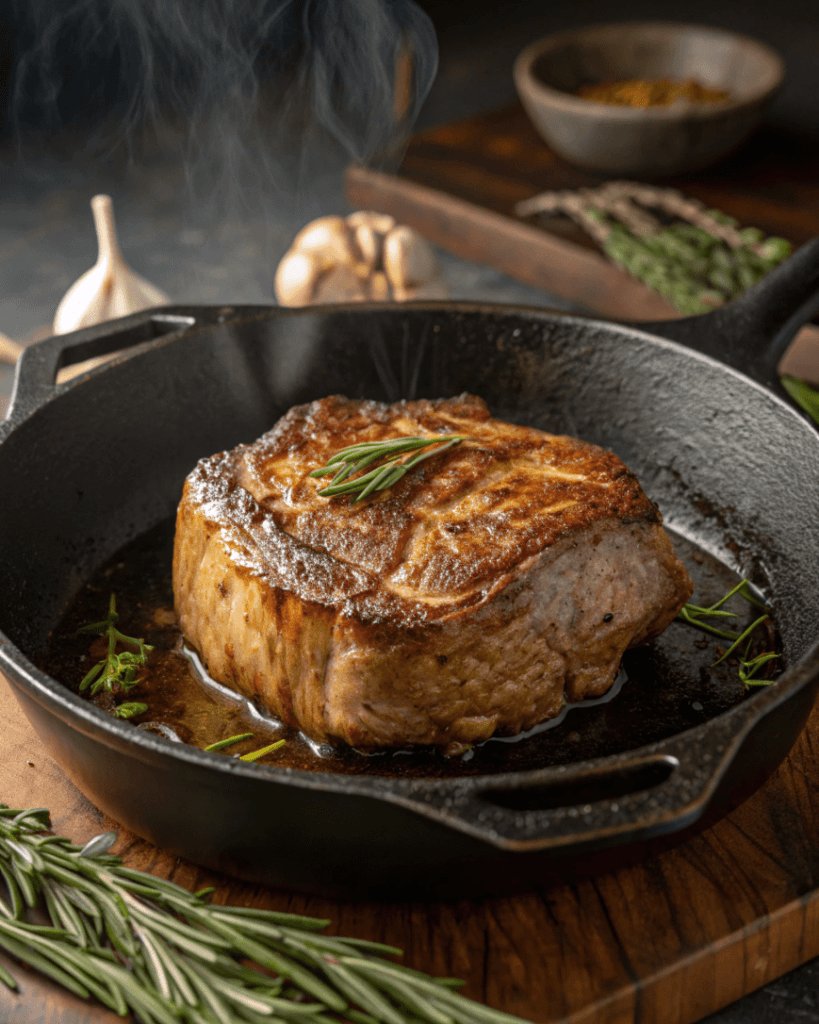
On the other hand, high-heat roasting works best when you’re short on time. It involves blasting the roast with high heat to quickly cook the exterior while keeping the inside juicy. This method creates a more pronounced crust but requires close monitoring to avoid overcooking.
For the ultimate ribeye roast, you can even combine both methods. Start with a high-heat sear to lock in the juices, then switch to slow roasting for even doneness.
Here’s a quick comparison of the two methods:
| Method | Temperature | Time | Benefits |
|---|---|---|---|
| Slow Roasting | 250\u00b0F – 300\u00b0F | 2-3 hours (depending on size) | Tender, evenly cooked roast |
| High-Heat Roasting | 450\u00b0F – 500\u00b0F | 30-45 minutes (shorter time) | Crispy exterior, juicy interior |
| Combination | High heat + low heat | High heat (15 mins) + low (1-2 hours) | Best of both worlds (crust + tenderness) |
By understanding these techniques, you can customize the cooking process to fit your schedule and preferences. For those who enjoy smoked flavors, try experimenting with a smoked salmon brine recipe, which incorporates rich, savory notes that complement roasted dishes.
The Art of Searing a Ribeye Roast Recipe: Tips for a Golden Crust
Searing your ribeye roast is the secret to a mouthwatering golden crust. It locks in the natural juices while adding a rich, caramelized flavor. Think of it as the foundation of a perfect roast.
Start by heating a heavy pan, like cast iron, over medium-high heat. Add a little oil with a high smoke point, such as avocado or vegetable oil. Once the oil is shimmering, carefully place the roast in the pan.
To get that beautiful crust, don’t move the roast too much. Let it sear for 2-3 minutes per side until you see a golden-brown layer. Then, flip and repeat on all sides.
For better clarity, here are key tips for searing success:
- Use a heavy-bottomed skillet to distribute heat evenly.
- Ensure the pan is hot before adding the roast.
- Don’t overcrowd the pan; the roast needs space for proper searing.
- Press the meat lightly against the pan for full surface contact.
- Let each side sear for 2-3 minutes without flipping too soon.
Here’s a quick chart of the searing process:
| Step | Action | Time Required |
|---|---|---|
| Heat the Pan | Medium-high heat | 2-3 minutes |
| Add Oil | Use high-smoke-point oil | 1 minute |
| Sear First Side | Don’t move the roast | 2-3 minutes |
| Flip and Repeat | Sear all sides evenly | 6-8 minutes total |
Searing gives your ribeye roast a professional finish, making it look and taste absolutely amazing. By following these steps, you’ll create a crust so good it’ll have everyone asking for seconds!
For adventurous cooks, soaking and marinating meat can elevate flavor. Discover if beef heart should be soaked before cooking for an in-depth look at tenderizing tougher cuts.
Perfect Side Dishes and Sauces for Ribeye Roast
Top Side Dishes to Pair with Ribeye Roast
Pairing the perfect side dishes with your ribeye roast can take your meal from great to unforgettable. A hearty cut like ribeye roast shines even brighter when paired with sides that balance its rich flavor. First, classic mashed potatoes are a must. Their creamy texture complements the tender juiciness of the roast perfectly. Add a drizzle of gravy, and you have a crowd-pleaser.
Next, roasted vegetables are a healthy and colorful choice. Try carrots, Brussels sprouts, or green beans tossed in olive oil and seasoned lightly. Their natural sweetness pairs beautifully with the roast’s savory flavors. In addition, a fresh, crisp salad can add a refreshing contrast. Think mixed greens with a light vinaigrette or a Caesar salad with crunchy croutons.
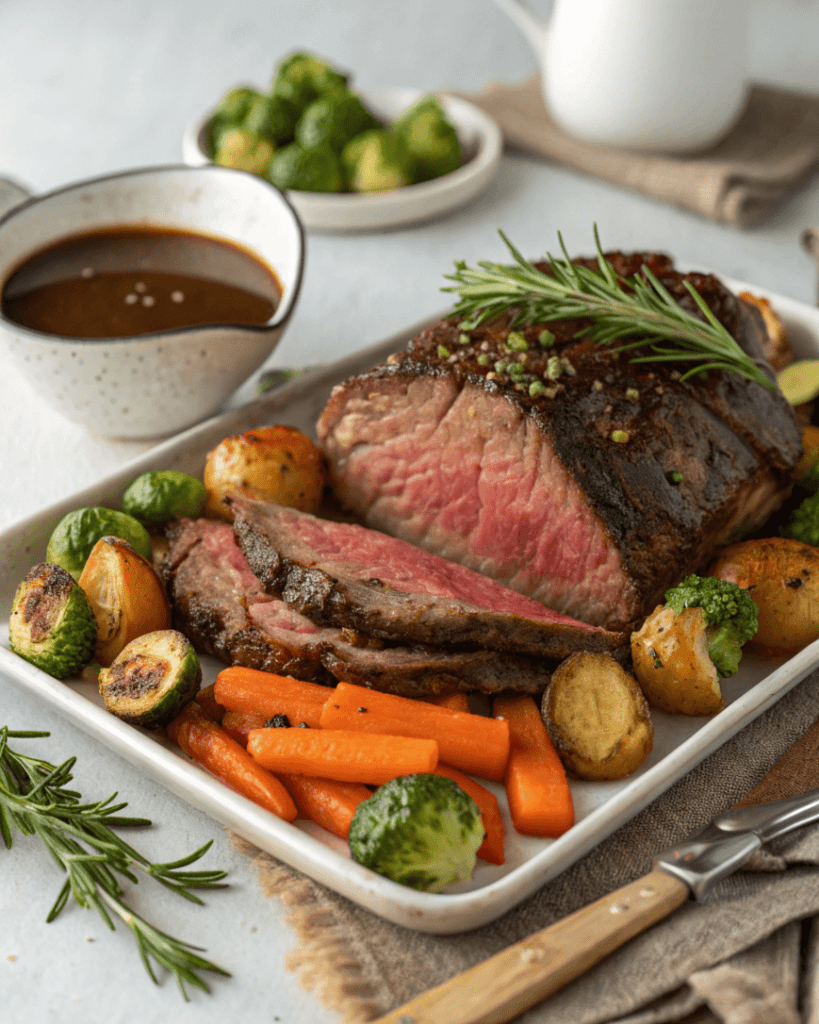
Here’s a quick list of popular side dishes:
- Creamy mashed potatoes with gravy
- Roasted Brussels sprouts or carrots
- Garlic butter green beans
- Fresh Caesar salad or mixed greens
- Soft, buttery dinner rolls
For balance, consider adding a starchy dish like herb-roasted potatoes or a wild rice pilaf. Both pair seamlessly with the ribeye roast.
Here’s a simple comparison of side dish types:
| Side Dish Type | Examples | Why It Works |
|---|---|---|
| Starchy | Mashed or roasted potatoes | Balances richness of the roast |
| Vegetables | Roasted carrots, green beans | Adds freshness and texture |
| Salad | Caesar or vinaigrette greens | Lightens the meal |
By choosing a mix of these, your ribeye roast will have the perfect sidekick for every bite. Looking for more ways to create bold and flavorful meals? Browse beef heart recipes for inspiration that goes beyond traditional sides.
Making Rich, Flavorful Sauces to Complement Your Roast
A great sauce can transform your ribeye roast into a masterpiece. One of the easiest and most flavorful options is a simple pan sauce made from the drippings. These sauces are quick to make and pack a punch of flavor.
First, after roasting the ribeye, use the drippings left in the pan. Add a splash of beef broth to deglaze the pan, scraping up all those tasty brown bits. Next, stir in a little butter and some herbs like thyme or rosemary for added depth. Let it simmer until slightly thickened.
For an extra kick, consider a creamy horseradish sauce. Mix sour cream, prepared horseradish, lemon juice, and a touch of garlic. It’s tangy, zesty, and pairs perfectly with the richness of the ribeye roast.
Here are a few sauce ideas and tips:
- Classic Pan Sauce: Made with drippings, beef broth, and butter.
- Garlic Herb Butter: Mix softened butter with minced garlic and fresh herbs.
- Creamy Horseradish Sauce: A tangy blend of sour cream and horseradish.
- Red Wine Reduction: Skip the wine and use grape juice or extra broth for an alcohol-free version.
Here’s a chart of sauce pairings:
| Sauce | Ingredients | Flavor Profile |
|---|---|---|
| Pan Sauce | Drippings, broth, butter, herbs | Savory, rich |
| Garlic Herb Butter | Butter, garlic, rosemary, thyme | Creamy, aromatic |
| Creamy Horseradish Sauce | Sour cream, horseradish, lemon juice | Tangy, zesty |
By adding a well-crafted sauce, your ribeye roast will impress even the toughest critics. The right sauce enhances every bite, making it a truly memorable meal!
How to Store, Reheat, and Repurpose Ribeye Roast Leftovers
Best Practices for Storing Leftover Ribeye Roast
Storing leftover ribeye roast properly is the key to preserving its juicy, tender texture and bold flavor. First, make sure the roast has completely cooled to room temperature before storing it. This prevents condensation and keeps it fresh longer. Next, wrap it tightly in aluminum foil or place it in an airtight container. Proper wrapping seals in the moisture and protects it from freezer burn.
If you’re planning to eat it within a few days, store the roast in the refrigerator. It will stay fresh for up to 3-4 days. For longer storage, freezing is your best bet. Slice the roast into portions before freezing to make reheating more convenient. Label the container with the date to keep track of freshness.
Here’s a quick table for storage guidelines:
| Storage Method | How to Store | How Long It Lasts |
|---|---|---|
| Refrigerator | Wrap tightly; use airtight container | Up to 3-4 days |
| Freezer | Slice and freeze in portions | Up to 3 months |
Following these steps ensures your ribeye roast leftovers remain delicious and ready to enjoy whenever you want.
Creative Ways to Use Ribeye Roast Recipe in New Dishes
Leftover ribeye roast can be repurposed into exciting new dishes that make it feel like a fresh meal. First, thinly slice the roast and use it to make hearty sandwiches. Add crusty bread, melted cheese, and a dollop of horseradish sauce for a flavor-packed bite.
Next, you can dice the roast into small cubes and toss it into a stir-fry with your favorite veggies. It’s a quick, healthy meal that’s bursting with flavor. Another great idea is to shred the meat and use it as a topping for loaded baked potatoes or nachos. It adds a rich, meaty twist to these classic comfort foods.
Here are some fun ideas for repurposing:
- Sandwiches: Slice thinly and layer with cheese and veggies.
- Stir-Fry: Add diced roast to a skillet with vegetables and soy sauce.
- Loaded Potatoes: Top baked potatoes with shredded ribeye and your favorite toppings.
- Tacos: Wrap shredded roast in tortillas with salsa and guacamole.
- Beef Salad: Toss cold slices with greens, vinaigrette, and nuts for a refreshing meal.
Here’s a chart of leftover uses:
| Dish | How to Prepare | Why It Works |
|---|---|---|
| Sandwiches | Thin slices, crusty bread, cheese | Simple and satisfying |
| Stir-Fry | Cubed meat with veggies | Quick and versatile |
| Loaded Potatoes | Shredded meat as a topping | Comfort food with a twist |
Using leftovers creatively not only reduces waste but also gives you an excuse to enjoy the flavors of your ribeye roast in fun, new ways. Once you try these ideas, leftovers will never feel boring again!
Perfectly Tender Ribeye Roast with Garlic Herb Crust
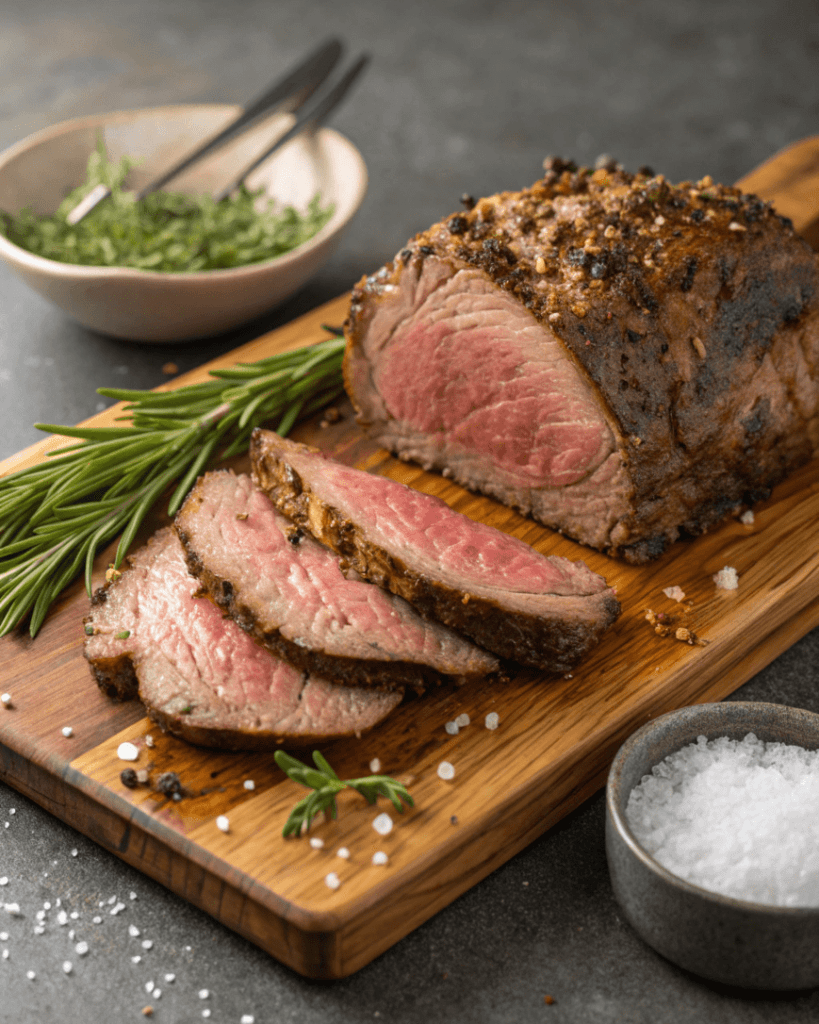
Now that you’ve got all the tips and tricks for mastering a ribeye roast, it’s time to roll up your sleeves and dive into the star of the show—our Perfectly Tender Ribeye Roast Recipe with Garlic Herb Crust. Let’s turn your kitchen into a steakhouse!
Ingredients
Every great dish begins with stellar ingredients, and this ribeye roast recipe is no exception. Let’s dive into what makes this dish shine:
- Ribeye Roast (4-5 pounds) – This is the star of the show. Its marbling ensures tenderness, while its rich flavor guarantees a mouthwatering experience. Always choose a cut with creamy white fat for the best results.
- Olive Oil (3 tablespoons) – Olive oil creates a beautiful crust and helps the seasonings stick to the meat. It also adds a touch of richness to the roast.
- Sea Salt (2 teaspoons) – This essential seasoning enhances the natural flavors of the beef and creates a savory balance.
- Black Pepper (1 teaspoon) – Freshly ground pepper adds a gentle heat and depth that complements the beef beautifully.
- Garlic (4 cloves, minced) – Garlic infuses the roast with a warm, aromatic flavor that’s simply irresistible.
- Fresh Rosemary (1 tablespoon, chopped) – Rosemary adds a woodsy, fragrant touch that pairs perfectly with beef.
- Fresh Thyme (1 tablespoon, chopped) – Thyme brings a subtle earthiness, elevating the overall flavor.
- Smoked Paprika (1 teaspoon) – This adds a mild smokiness and a pop of color to the roast.
- Onion Powder (1 teaspoon) – Onion powder enhances the savory profile, tying all the flavors together.
- Beef Broth (1 cup) – This keeps the roast moist during cooking and can be used to make a flavorful pan sauce.
First, gather these fresh, high-quality ingredients to set the stage for a fantastic ribeye roast. Next, prepare to bring them together for a truly unforgettable dish!
Step-by-Step Instructions
Let’s make this ribeye roast recipe your new go-to for special occasions or hearty family dinners. Follow these steps:
- Prepare the Ribeye Roast – Remove the roast from the fridge and let it sit at room temperature for 30 minutes. This ensures even cooking.
- Season the Roast – Pat the roast dry with paper towels, then rub it all over with olive oil. Sprinkle generously with salt, pepper, garlic, rosemary, thyme, smoked paprika, and onion powder. Let the flavors meld for 10 minutes.
- Preheat the Oven – Heat your oven to 450°F (232°C). A hot oven sears the exterior and locks in the juices.
- Sear the Roast – In a large skillet, heat a bit of olive oil over medium-high heat. Sear the roast on all sides for 2-3 minutes each until golden brown.
- Roast to Perfection – Place the seared roast on a rack in a roasting pan. Pour the beef broth into the pan. Roast at 450°F for 15 minutes, then reduce the heat to 325°F (163°C) and cook until the internal temperature reaches 125°F (52°C) for medium-rare or 135°F (57°C) for medium.
- Rest the Roast – Remove the roast from the oven, cover it with foil, and let it rest for 15-20 minutes. This allows the juices to redistribute.
- Slice and Serve – Use a sharp knife to slice the roast against the grain into thin slices. Serve with your favorite sides and enjoy!
Serving
This recipe serves 6-8 people, making it perfect for gatherings or a cozy family dinner. Serve it with:
- Mashed Potatoes – Creamy and comforting, they’re the ultimate pairing.
- Roasted Vegetables – Think carrots, Brussels sprouts, or green beans for a colorful addition.
- Fresh Salad – A crisp green salad with vinaigrette adds a refreshing contrast.
For a fun twist, try serving the roast with soft dinner rolls and herb butter on the side. You’ll elevate the dining experience to steakhouse quality!
Tips and Hacks
Take your ribeye roast recipe to the next level with these tips:
- Buy Quality Meat – Always choose a well-marbled ribeye roast for maximum flavor and tenderness.
- Use a Meat Thermometer – This ensures perfect doneness without guesswork.
- Rest is Key – Allowing the roast to rest after cooking ensures juicy slices.
- Save the Drippings – Use the flavorful pan drippings to create a delicious gravy or au jus.
- Make-Ahead Tip – You can season the roast a day in advance to deepen the flavors.
- Storage – Leftovers? Store slices in an airtight container for up to 3 days or freeze for up to 3 months.
Nutrition Facts
- Serving Size: 6 ounces
- Calories: 450
- Fat: 35g
- Carbs: 2g
- Protein: 38g
- Sodium: 520mg
- Fiber: 0g
Please note: Nutrition estimates may vary based on ingredient brands, portion sizes, and preparation methods.
Prep Time
- Prep Time: 20 minutes
- Cook Time: 1 hour 45 minutes
- Total Time: 2 hours 5 minutes
Please note: Prep time is an estimate and may vary depending on individual cooking speed.
Frequently Asked Questions (FAQs)
Is a ribeye roast the same as a prime rib roast?
A ribeye roast and a prime rib roast come from the same part of the cow, but they aren’t identical. A ribeye roast is typically boneless, while a prime rib usually has the bone. The ribeye is easier to cook and carve, making it a popular choice. Both cuts are rich and tender, perfect for a ribeye roast recipe that impresses everyone.
What temperature should ribeye roast be cooked at?
For a tender and juicy ribeye roast, cook it at 450°F for the first 15 minutes. Then, reduce the temperature to 325°F and cook until the internal temperature reaches 125°F for medium-rare. Using a meat thermometer ensures perfect doneness every time. This step is crucial to making a ribeye roast recipe that’s full of flavor and perfectly cooked.
Is ribeye good for roasting?
Absolutely! Ribeye is one of the best cuts for roasting because of its natural marbling. The fat melts during cooking, keeping the meat tender and juicy. It’s also versatile, working well with various seasonings and cooking techniques. A ribeye roast recipe is always a showstopper, whether for a holiday meal or a special family dinner.
Should I sear a ribeye roast before cooking?
Yes, searing your ribeye roast is a game-changer. It creates a golden crust that locks in the juices and adds incredible flavor. Heat a skillet over medium-high heat, add some oil, and sear the roast for 2-3 minutes per side. This step ensures your ribeye roast recipe looks and tastes like it came from a gourmet kitchen.
Conclusion: Master the Art of Ribeye Roast for Any Occasion
Creating the perfect ribeye roast recipe is easier than you think. With the right ingredients, simple steps, and a touch of love, you can craft a meal that feels gourmet. First, choosing a well-marbled ribeye roast sets the stage for success. Then, seasoning it with care ensures every bite bursts with flavor.
Next, remember that slow roasting paired with a golden sear makes all the difference. Also, don’t forget to let the roast rest before slicing. This keeps it juicy and tender. The best part? A ribeye roast recipe works for holidays, family dinners, or any special occasion.
Once you serve this dish, you’ll see smiles all around the table. It’s satisfying, comforting, and truly unforgettable. So, grab your apron and start your ribeye roast journey today. You’re going to love how simple and rewarding it is!

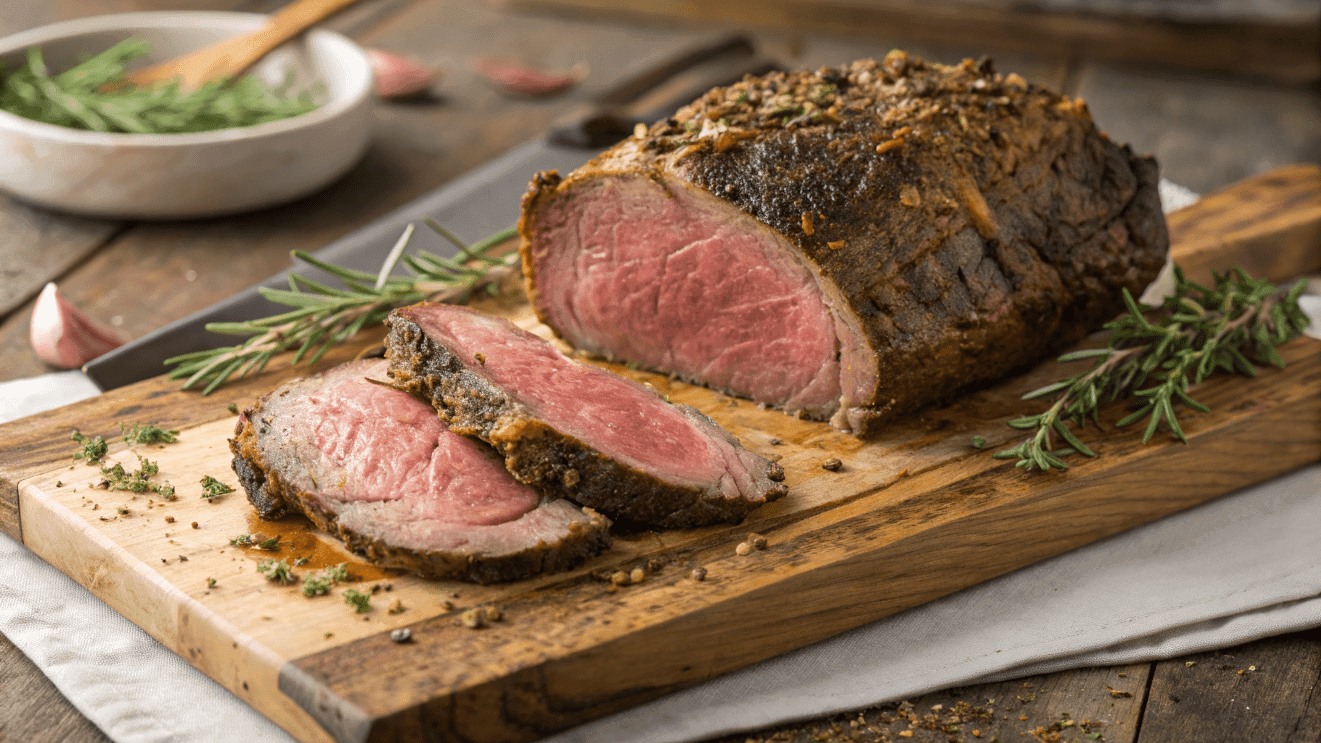
1 thought on “Ultimate guide to Make the Perfectly Tender Ribeye Roast Recipe”